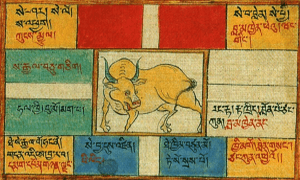Tibetan Astrology
History of Tibetan Astrology
Tibetan astrology through the ages
Before 2nd century B.C.
In the ancient times, the shamanistic Bön religion was the main cult in Tibet, and Elemental astrology was already practiced, but only a little is known of its original form. There was already knowledge of the five elements Wood, Fire, Earth, Iron and Water and the phases of Moon and Sun. The divination and prediction system was shamanistic with black and white magic, exorcism, sacrifice of animals and human blood letting.
2nd century B.C. - 4th century A.D.
During the reign of Tibet's first king, Nyatri Tsenpo (who ascended the throne in 127 B.C.)twelve major Bön doctrines were created with a detailed system of categories and sub-categories. Astrology and medicine were among those categories.
In time more knowledge of astrology developed, but it is difficult to place the timing of it. Bön astrologers connected the five elements together with Srog (lifeforce element), Lus (body - health element), Wangthang (empowering force) and Lungtha (success element). They also observe nine magic Mewa square numbers, and the system of twelve animal years started to form. From China comes the principle of eight Parkha trigrams (also known from I Ching).
4th century A.D
The first Buddhist teachings and scriptures came to Tibet and also bought advances in astrology and astronomy.
Role of Tibetan astrology
Brief History of Tibetan Astro. science and the role of Tibetan Astrology in Tibetan society.
What is Tibetan Astrology?
Tibetan Astrology, originated from The ancient Bon cultures dating back over 5000 years. The Bon historical texts gave evidence to a cultural heritage rich in the arts, philosophy, religion and science. The Bon of the astrological sciences (gtsug lag rtsis kyi bon) belongs to the series of the ‘Shen of the Cha’, and it is handed down that the master Shenrab Miwoche taught it to the ‘Shen of the Cha’ Legyel Thangpo and other disciples.
Among the ‘twelve lores’ of Bon astrology appears with the name’ The Astrologer, Who Knows how to Control the order of Existence’ (skos shes rtsis mkhan) and the term Ko ( skos: lit.’the person entrusted’) is to be understood as an attribute of the person ( the astrologer). Astrology is considered one of the most important limbs of the ten field of science in Tibetan culture. It is commonly known in Tibet as “Science of Light”. It is the remover of the darkness of ignorance, it is the eye of divine knowledge which is pure, supreme and exhalted.
Brief History of Tibetan Astro. science
Brief History of Tibetan Astro. science
Tibet, as well as within the Buddhist cycle. Though it shares similarities with the Indian Astrology and Chinese system of astrology, it looks more in a complete sense. Tibetan system of Astrology is the unification of all the essence lore of astrology from our neighboring countries such as Kalachakra Astrology from India and Chinese system of Elemental astrology, which makes it unique in itself. However, Tibet had a rudimentary system of astrology based primary on the Bon Tradition and ancient culture of Tibet before the advent of Buddhism. This science is classified into three categories. There are: Astronomy (sKar rtsis), Elemental Astrology ('byung rtsis) and Shiva Sarvodaya Tantra (byang 'char). Many people who are not familiar with Tibetan Astro. science believe that Astronomy (skar rtsis) was spread from India after translating Kalachakra Tantra into Tibetan and Elemental astrology from China. And others, who are not aware of the ancient Tibetan Astrological science, may believe that there was no knowledge on Tibetan astrology and astronomy in Tibet before 3rd century and earlier to the King Nyatri Tsenpo. However, this believe is not at all justifiable and distorts the real history of ancient Tibetan astrology. So I would like to clarify this wrong belief and notion about the history of Tibetan Astrological science by narrating what the history tell us about the sequence of development in Tibetan Astrology.
Astronomy earlier to the 1st King of Tibet (Nyatri Tsenpo)
 Tibetan Astrology
Tibetan Astrology

 Phugpa
Phugpa
 Lineair
Lineair
 Single zigzag
Single zigzag
 Full zigzag
Full zigzag













